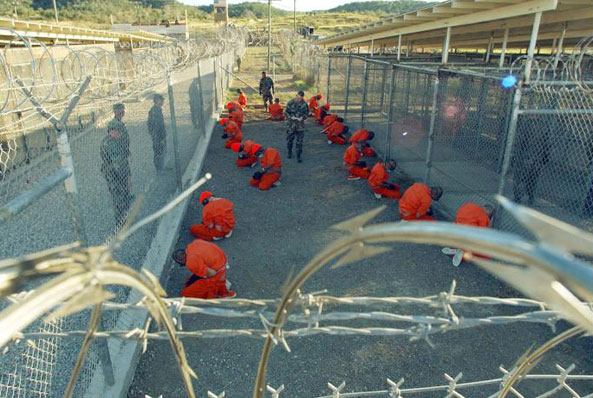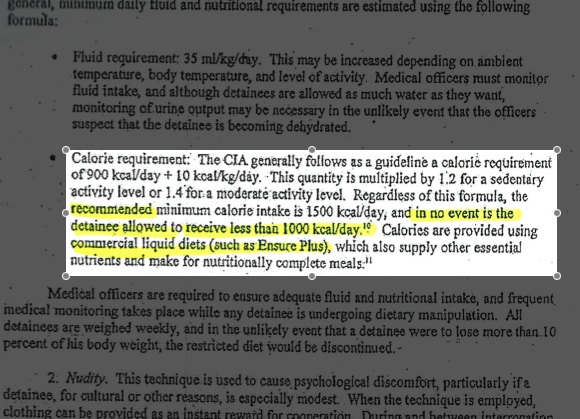Limiting Food Aided ‘Enhanced Interrogations’
The CIA said techniques like sleep deprivation worked better when a detainee’s resistance was weakened from hunger.
Jul 31, 20201.2M Shares17.1M Views
Salim Hamdan, Osama bin Laden's alleged driver, was held in Cuba at Guantanamo Bay prison camp like these detainees. (Department of Defense photo by Petty Officer 1st class Shane T. McCoy, U.S. Navy)
According to a recently declassified Justice Department document, the CIA believed that so-called “enhanced interrogation” techniques like sleep deprivation worked better when a detainee’s resistance was weakened from hunger. The agency, with the legal approval of the Justice Department, employed a regimen that sharply restricted the caloric intake of detainees in its custody — an intake distinctly below federal nutritional guidelines for inmates in U.S. prisons.
Illustration by: Matt Mahurin
Steven Bradbury, chief of the Justice Department’s Office of Legal Counsel in during George W. Bush’s second term, provided an overview of an authorized CIA technique to manipulate detainee’s diets in order to make them receptive to interrogation. Using references to calories, Bradbury wrote in a May 10, 2005 memo, “[T]he recommended minimum calorie intake is 1,500 kcal/day, and in no event is the detainee allowed to receive less than 1,000 kcal/day.” While having his diet restricted, a detainee would be fed not solid food, but “commercial liquid diets (such as Ensure Plus).” The restricted diet, according to Bradbury’s memo, would be subject to “frequent medical monitoring,” and a detainee would be measured “weekly” to ensure that he did not lose more than “10 percent of his body weight,” which would trigger termination of the diet.
That caloric intake would be unacceptable for the Justice Department to administer to an inmate in a federal prison. The department’s Bureau of Prisons requires federal prisons to adhere to “the Daily Reference Intake (DRI) for nutrients published by the Food and Nutrition Board of the National Academy of the Sciences” in order to “ensure proper nutrition,” according to the bureau’s 2006 policy handbook. The National Academy of the Science’s Dietary Reference Intakes estimates nutritional requirements on a sliding scale depending on Body Mass Index and level of activity. But for adult men who stand just under five feet tall and who maintain a “sedentary” level of physical activity with a low body mass index, the minimum caloric requirement in the guideline is 1,848 calories. All other nutritional elements of the guideline require greater caloric intakes for adult men, ranging from 2,000 to 3,720 calories.
States maintain different standards but hover around that range. In 2003, controversy resulted when Texas cut the caloric requirement for its inmates to 2,500 calories per day from 2,800in order to close a budget shortfall.
“For men, you’re going to need at least 2,100 [calories], for most men, and probably 2,300 for weight maintenance,” said Katherine Tallmadge, a dietician who runs Personalized Nutrition, a weight-management company in Washington. “For most women, 1,500 is a weight loss level. And so for most men, 1,800 is a weight loss level. A thousand or 1,500 is extremely low for a man.” The weight-management formula used by the CIA and listed in the OLC memo appeared to Tallmadge to be “a little low” compared to industry standards.
Adult men “should be taking 2,000 to 3,000 [calories] a day, based off of activity level,” said Angela Ginn-Meadow, a dietician with the Joslin Diabetes Center in Baltimore. “Anything below 1,200 calories a day can put you at risk of malnutrition, vitamin and mineral deficiency.” Both Tallmadge and Ginn-Meadow are national spokeswomen for the American Dietetic Association.
“It’s not starvation, but it’s problematic,” agreed Scott Allen, a Rhode Island-based doctor and medical adviser to Physicians for Human Rights. Allen said that his middle-aged male patients who exhibit an active lifestyle are often placed on a 2,000-calorie daily intake “as a weight loss diet.”
Bradbury’s 2005 memo, declassified on April 17 by the Obama administration, explained that the CIA believed manipulating a detainee’s diet “makes other techniques, such as sleep deprivation, more effective.” Applied in practice, the CIA induced sleep deprivation on detainees by restraining them in “stress positions,”such as shackling their ankles to a cell floor and their wrists from the ceiling. The former OLC chief further wrote in a footnote that the fact that commercial weight loss programs “employ diets of 1,000 kcal/day for sustained periods” was “instructive in evaluating the medical safety of the interrogation technique.” He allowed that “detainees subject to dietary manipulation are obviously situated differently from individuals who voluntarily enage in commercial weight-loss programs.” Bradbury is not a doctor.
The CIA would not discuss the genesis of its caloric guidelines. But an official familiar with the former interrogation program pointed to the memo’s footnote about commercial weight-loss programs in the U.S. containing 1,000 calories per day. “The 1,000 figure was for short-term use only,” the official said. “While there are obvious differences between a dieter and a detainee, any suggestion of starvation would be flat wrong.”
Emily Siegel, a Baltimore-based nutritional counselor who works with trauma victims, said that while the detainees’ physical activity would not be high during interrogation, “the stress their bodies are under is tremendous,” requiring more calories than the CIA program allowed.
Orlando Ticon, a survivor of torture directed by former Philippine dictator Ferdinand Marcos, described what dietary manipulation feels like. “The main thing was you never knew when you were given food,” said Ticon, who now works with a torture survivors’ support group known as TASSC International. “For me, I was blindfolded and hogtied for about three months. For the first weeks, I was not allowed to feed myself. Someone was feeding me, literally,” but without any predictability of when he would receive food.
In the long term, Ticon said, torture survivors experience a lingering lack of appetite, associated with post-traumatic stress disorder. “Some survivors lose a taste for food because it’s identified for them with prison,” he said. “Like certain types of food, like dried bread, tea, things like that.” Torture survivors he has interviewed “don’t eat regularly and have no appetite for food.”
Detainees who had been subjected to the CIA’s detention program described being subjected to the regimen for weeks in a 2007 report by the International Committee of the Red Cross. Khalid Shaikh Mohammed, the architect of the 9/11 attacks, said he was not provided “with any solid food apart from on two occasions as a reward for perceived cooperation,” and fed only Ensure. “If he refused to drink then his mouth was forced open by a guard and the Ensure was poured down his throat,” the report states. Mohammed claimed to the Red Cross that his weight dropped from 78 kilograms, or 171 pounds, to 60 kilograms, or 132 pounds, after the month-long regimen of dietary restriction. If true, that would amount to a loss of about 23 percent of Mohammed’s body weight — more than twice the amount that, according to Bradbury’s memo, should have stopped the dietary-restriction regimen.

Paolo Reyna
Reviewer
Paolo Reyna is a writer and storyteller with a wide range of interests. He graduated from New York University with a Bachelor of Arts in Journalism and Media Studies.
Paolo enjoys writing about celebrity culture, gaming, visual arts, and events. He has a keen eye for trends in popular culture and an enthusiasm for exploring new ideas. Paolo's writing aims to inform and entertain while providing fresh perspectives on the topics that interest him most.
In his free time, he loves to travel, watch films, read books, and socialize with friends.
Latest Articles
Popular Articles


